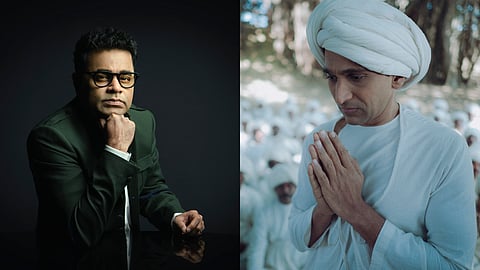

The Primetime section of the Toronto International Film Festival or TIFF, which celebrated its 50th year earlier this month, featured a series from India for the first time this year. Fittingly, the series created by Hansal Mehta and Sameer Nair, and directed by Hansal, was Gandhi. It was about an iconic character whose story could struggle to fit even into a multi-part series. Although only the first two episodes of the first season were shown at TIFF, the spectacular cinematic scope of the project was enough to create a craving for the rest of the series.
When Gandhi is mentioned in the context of the screen, the reference for over four decades has been Richard Attenborough’s Oscar-winning film of the same name. While that 1982 film chronicled the Mahatma, the Father of the Nation, Hansal's Gandhi introduces us to Mohaniya, the son, brother, and the family man. Taking star billing all on its own in Hansal’s series is the music composed by AR Rahman. Here again, Rahman demonstrates his effortless ability to move between Indian classical, folk, and Western classical music, as the situation demands. Hansal, who had never worked with Rahman before, cold-called him for this series, and after sending him rough cuts of the first four episodes, won over the composer. Speaking to CE in Toronto, Rahman says, “I was blown away. So I called him (Hansal) and said, 'What have you done? It's so beautiful.' Then, we started scoring.”
The creation of the series began with Applause Entertainment’s CEO, Sameer Nair, acquiring the rights to historian Ramachandra Guha’s books Gandhi Before India and Gandhi: The Years That Changed the World. “See the thing about Gandhi is his story is timeless,” says Hansal, adding, “But we don't know the human story. We don't know enough of it. So any young person who has dreams, ambitions, aspirations, is fascinated by going abroad…it’s every young person’s story. But in that, it's about exploring oneself, self-discovery, discovering injustice, inequality, and finding that resilience and strength to overcome it with nonviolence.”
Rahman says he drew from Gandhi’s own favourite pieces of music for his score. “You know the two biggest influences of the aura of Gandhi, like 'Vaishnava jana toh' and 'Raghupati Raghava Raja Ram'…and so Jaijaivanti and Pilu are ragas which are very close to what I felt like the themes could be in, and Sahana from Carnatic music.” Rahman even got a solo violin player to play 18 times and make it sound like an entire Indian violin section. Explaining his decision, Rahman says, “I tried to get an Indian violin section that can play with all the gamakas (embellishment between notes), but I couldn't get them to play together. So we got one girl called Ranga Priya to record 18 times for all the themes and then orchestrated the whole thing.” Other compositions were recorded in his own studio and in Budapest.
The ambition of the series is reflected in the locations. We see Gandhi in his native Gujarat, in the UK, in Mumbai, and in South Africa. While they shot extensively in the UK, Hansal said the South African locations were recreated in India. The title role is played by Pratik Gandhi, an actor who has been playing the role of Gandhi for a decade in a Gujarati play. Bhamini Oza Gandhi, who is married to Pratik in real life, plays Kasturba. Harry Potter fans will be delighted by Tom Felton’s turn as an advocate of vegetarianism in London, who takes Gandhi under his wing during his early days in London. Kabir Bedi makes an appearance as Dadabhai Naoroji.
While the production shows an admirable commitment to authenticity and period details, Hansal also kept the contemporary appeal going with his team. “The language, the humour, the drama, is all very contemporary…the average age on my team is around 28-29. They were not all familiar with Gandhi, and that's the beauty. I wanted them to discover Gandhi with me. Otherwise, what happens is it becomes heavy-handed,” points out Hansal. While Rahman’s global stardom was ignited by TIFF, with Slumdog Millionaire becoming the sleeper hit of the film festival in 2008, and then going on to win eight Oscars, including two for Rahman, this year was surprisingly his first attendance at TIFF. Hansal, meanwhile, had brought his films to TIFF twice before he pitched Gandhi for this year’s festival. “TIFF has one of the greatest and yet very demanding film audiences among all the festivals. It's unlike the European audiences. It's more informal, but also very exacting,” says Hansal.
With Hansal planning to complete post-production in about three months, plans for its licensing would be next on the cards. In fact, after it premiered at TIFF, Hansal reveals that he was very tempted to release it on the big screen: “I saw it on the big screen that day with the audience at the premiere, and suddenly, I felt, why not? I asked Sameer if we can release it in the cinema halls?”
Signing off, Rahman says, “I think the series is catering to international audiences, and it's our export to the Western world. The last time there was a British guy who made Gandhi. So now a pack of all Indian people are doing this, and we want this to be the kind of quality, which you know, we have arrived with.” Forty-three years after anchoring a blockbuster movie, Mohandas Karamchand Gandhi awaits another turn on global screens, this time in a story told by his compatriots.